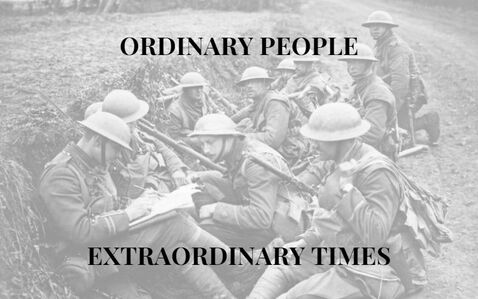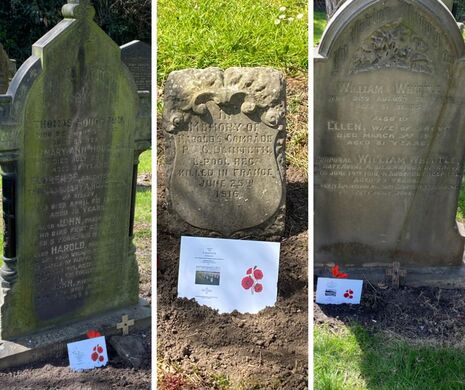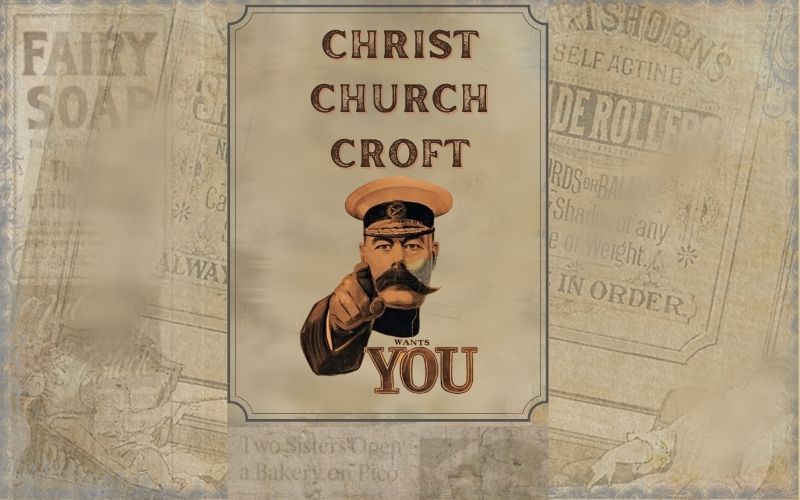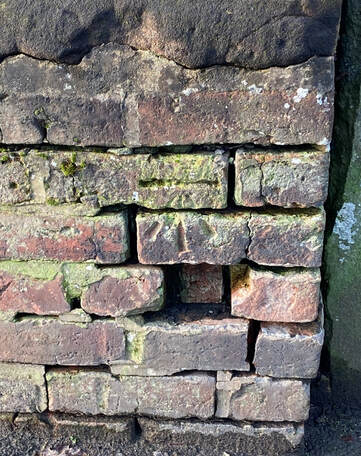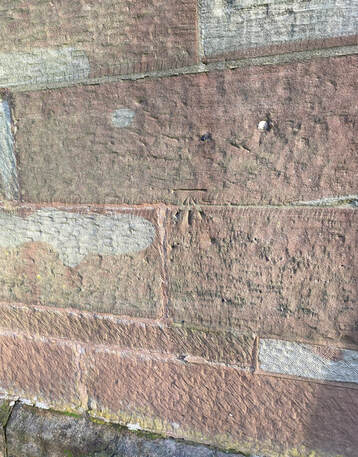WAR GRAVES WEEK 2022War Graves at Croft Unitarian ChapelRifleman Harold HoughtonHarold Houghton was born in 1890 in Croft when his father, Thomas, was 31 and his mother, Mary, was 28. He had four brothers and four sisters.
In 1911 he lived at The Old Noggin Inn, Risley with his parents, his brother and two of his sisters He worked at the Albion Ironworks in Leigh. On 2nd September 1914 he joined the 5th Rifle Brigade, A Company, 2nd Battalion On 24 March 1915 he died of his wounds from the battle of Neuve Chapelle, aged 25. He was buried at Croft Unitarian Chapel, the grave stone stating ‘He Died for his Country’s Honour’. Private George DaintithWhen George Daintith was born on 24 February 1892 in Culcheth, his father, Thomas, was 25 and his mother, Mary, was 21. He was christened at Newchurch on 17th April the same year.
His mother Mary passed away in 1906 and his father remarried in 1907. He had seven brothers and two sisters. In 1911 he lived with his father, stepmother and four of his brothers at The Old Noggin Inn, Risley. In April 1915, he joined Kitchener’s Army, enlisting in the 1st King’s Liverpool Regiment. After about a year’s training he was sent to the Front and was attached to the 251st Company Royal Engineers. He was killed in action on June 25th, 1916, in the ‘great push’ near Albert. Captain Hansen, R.E., in expressing his sympathy with his parents said: ‘Your son met his death on the night of June 25th while doing his duty, and I cannot speak too highly of his behaviour on this occasion, and ever since he joined this Company. I cannot say how deeply I felt his loss to my section, as he was one of my best men and could always be depended upon. He was a typical example of a true British Soldier, and died doing his duty to his King and Country and so great a cause. Your son was buried last night, and I have taken steps to have a cross placed upon his grave.’ A memorial service was held at Newchurch Parish Church on Sunday 23rd July 1916. George is buried in Cambrin Military Cemetery. Harold Houghton’s parents had a stone erected at Croft Unitarian Chapel in Harold’s grave space saying 'Private. George Daintith. In memory of Harold's comrade of the Liverpool Regiment, killed in France 25/06/1916'. Lance Corporal William WhittleWhen William Whittle was born in 1889 in Culcheth, his father, William, was 29 and his mother, Ellen, was 21. He had two brothers.
In 1911 he lived and worked at Oakwood Farm, Risley with his parents and brothers. He died on 14 June 1918 in France at the age of 29 and is buried at Terlincthun British Cemetery, Wimille. He is remembered on the family grave at Croft Unitarian Chapel, the stone stating ‘Duty Nobly Done’. War Graves at Christ Church, CroftGunner Samuel YatesRoyal Garrison Artillery. Died on 9th July 1920, aged 42.
Son of Samuel and Mary Yates; husband of Lizzie Hankin Yates, of Longford Cottages, Longford, Warrington. Private William ClarkeSouth Lancashire Regiment, transferred to as Private 584377, Labour Corps.
On 19th December 1918 he was admitted to the Military Hospital, Warrington with influenza and pneumonia. He passed away at 16:50 hours on the 26th November 1918. His history was of being unwell after he was gassed by mustard gas in France four months prior and he had chest trouble ever since. He was the son of John and was the husband of Bertha, remarried to Andrews, of Little Town, Croft. He had two children, Thomas and Vera. Newchurch War GravesPRIVATE F FAULKNER
South Lancashire Regiment Died 16th March 1918 SERGEANT CYRIL WHITTLE Royal Air Force Volunteer Reserve Died 23rd April 1944 PRIVATE JOHN CLARK PICK Manchester Regiment Died 31st May 1940 PRIVATE JOSHUE RICHARD CLEWORTH King's Own (Royal Lancaster Regiment) Died 25th November 1918 DRUMMER G LOCKE Leinster Regiment Died 8th May 1920 PRIVATE ARTHUR MONKS Royal Army Service Corps Died 18th January 1921 GUARDSMAN HUGH ARTHUR WOOD Welsh Guards Died 29 August 1921 St. Oswald's War GravesPRIVATE W B MIDDLETON
Leicestershire Regiment Died 29th March 1921 SERJEANT JOHN BUCHANAN Royal Army Medical Corps Died 27th October 1918 LEST WE FORGETI recently read an article in The Guardian, which was so thought-provoking, I felt I must share it with the community.
The article was written by Andrew Edwards of Sussex Archaeological Society. I won’t repeat it here in full, but I have picked out the key points: -We must enable communities to engage with heritage sites in ways that protect their own needs. -We must find new ways to open up these spaces, so they remain relevant and serve a purpose. -When a community can engage with these spaces, the whole economy and upkeep of a building improves as a result. -In treasuring the past, we must not forget about the present and the future. The article got me thinking about our parish church, Christ Church. The fact that the building is Grade II listed will not save and preserve it alone. We need to ask ourselves NOW, how do we see our church in thirty or forty years?There are many different answers, but here are 5 possible outcomes:
Obviously, number 1 would be the best possible outcome. The building is still serving its original purpose after 200 years.
This is also highly unlikely. Churches have faced this problem for a long time due to dwindling congregations. To show just how much these figures have decreased, I have used data from the 1851 Religious Census and current figures to produce these statistics. An average of 27% of the occupied households in Southworth with Croft attended this church DAILY in 1851. Number 2 is the most desirable outcome if number 1 isn’t possible. The benefits include: a sustainable future for a valued local heritage asset, new sources of grants and investment capital can be accessed to restore and develop the building, the ability to establish a more enterprising income generating management model that provides a more sustainable solution to future building management and maintenance, Influence on public perceptions, and local pride in their community, Increased community involvement and engagement in their local assets, Stimulating new uses and attracting new audiences to experience and access a local asset. Numbers 3 and 4 are certainly not wanted and number 5 would be devastating. How can the community influence the outcome?We need to look at this in several different ways.
How can we Prevent the unwanted outcomes (3, 4 and 5)? We do not want the building to be demolished. Either of numbers 3 or 4 could also lead to outcome 5. So, why are buildings usually demolished? Age and lack of maintenance – Old buildings have a weak infrastructure, due to the materials used deteriorating in quality over time, and therefore not reaching required health and safety standards anymore. Even if the building looks good, this will not necessarily reflect the quality of the structure. Poor ventilation and plumbing can sometimes be unsolvable without further damage. Money – Having an old building demolished (and rebuilt) will in many cases cost less than maintenance in the long term. Infested with Dangerous Pests or Materials – An abandoned building can become infested beyond repair with pests and toxic materials over time. It is common, especially in old industrial buildings, for toxic substances to fester in the walls, floors and pipework, so often the best option is to demolish it. All of these reasons could be used in the future, without action by ourselves to prevent it. If the active church congregation continues its rapid decline, the unwanted outcomes become much more likely. The church is currently open once a week for a Sunday service. It can’t open much less often than that and continue to be maintained. When the congregations reduce, so do the donations, which is what funds the upkeep of the church. This means that outcomes 1, 3 OR 4 could lead to outcome 5 eventually. (Of course, option 2 could also lead to eventual demolition at some point in the future, nobody knows anything for certain.) We need to ensure that the decisions taken by us now, ensure the best possible chance of preserving our heritage for the future. This includes both thirty years from now and in the longer term, for our descendants to enjoy. How can we achieve either of the desirable outcomes (1 and 2)? This is where YOU (the community) comes in. It would be unrealistic to think that the population will start actively worshipping or in some cases take on a new faith in order to save the building. It would not either be expected for the active church congregation to suddenly stop worshipping. Both the community and the church need each other to actively engage in creating a plan for the future. If this doesn’t happen, the church building and it’s history and heritage will slowly dwindle along with the congregation. I would love to hear ideas and opinions from all sides on how this can be achieved. I long for the day when I am writing a post showing some hope for the future of our local parish church. Many people choose Lady Lane in Croft as part of their local walk. Not many people will have noticed the symbols made up of straight lines that are carved into walls along the route. They are in fact bench marks. What are bench marks?Bench marks are the visible manifestation of Ordnance Datum Newlyn (ODN), which is the national height system for mainland Great Britain and forms the reference frame for heights above mean sea level. Most commonly, the BMs are found on buildings or other semi-permanent features. Although the main network is no longer being updated, the record is still in existence and the markers will remain until they are eventually destroyed by redevelopment or erosion. Where can I find the bench marks?There are two bench marks on Lady Lane. One is at Croft Unitarian Chapel and one is at Christ Church. The bench mark at Croft Unitarian Chapel is on the boundary wall, which means it is not in its original position, as Warrington Borough Council have rebuilt the wall. (It does seem to be at the correct height above the ground level). Croft Unitarian Chapel Bench Mark
Description: WALL ENTRANCE BURIAL GROUND WEST SIDE LADY LANE SOUTH EAST ANGLE Height: 22.8387m Height above ground: 0.4m Date verified: 1957 Christ Church Bench Mark Description: CHURCH WEST FACE CHRIST CHURCH TOWER EAST SIDE LADY LANE Height: 33.1592m Height above ground: 1.2m Date verified: 1957 |
AuthorCheyvonne Bower Archives
July 2024
Categories
All
|

